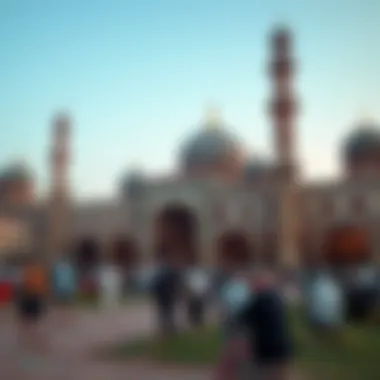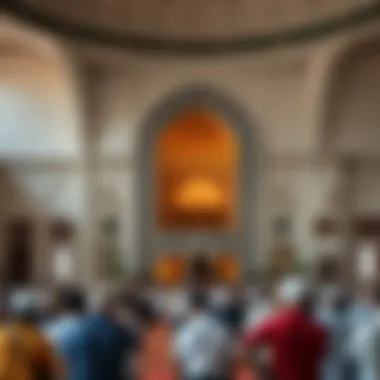Understanding Eid Prayer Time: Significance and Observance


Intro
Eid prayers hold a significant place within Islamic culture, marking not just the end of fasting during Ramadan or the culmination of the Hajj pilgrimage, but serving as a powerful moment of community gathering and individual reflection. Understanding the intricate details surrounding the timing and observance of these prayers offers deeper insights into their importance and relevance in today’s society. This article examines the historical context, cultural variations, and the significance of Eid prayer times, creating a comprehensive narrative that both resonates and informs.
The prayers themselves are more than a religious obligation; they embody a communal identity that transcends borders. From bustling mosques in Cairo to quiet prayer grounds in small towns, the essence of Eid can vary greatly. Yet, what remains consistent across all regions is the profound sense of belonging that the prayers foster. As we dive deeper, we'll explore how these time-honored traditions adapt to modern lifestyles, how different cultures celebrate, and how the communal aspects play a crucial role in the reinforcement of identity.
Through this exploration of Eid prayer times, we not only acknowledge the religious rites but also celebrate the social fabric that binds communities together. With this understanding, many can better appreciate the role these prayers play during such significant occasions.
Eid Prayer Time: An Overview
Eid prayer times mark a significant moment in the Islamic calendar, heralding not just religious observance but also community connection and personal reflection. These prayers, observed during the two major Eid celebrations—Eid al-Fitr and Eid al-Adha—offer a unique blend of spiritual and cultural significance.
What is Eid?
Eid, which translates to "celebration" in Arabic, refers to both Eid al-Fitr, celebrated after the month of Ramadan, and Eid al-Adha, commemorating the willingness of Ibrahim to sacrifice his son as an act of obedience to God. During Eid, Muslims gather for prayer, partake in festivities, and engage in acts of charity, cementing their bond within their communities. Each Eid brings its own flavor—Eid al-Fitr often features joy and feasting, while Eid al-Adha carries a deeper reflection on sacrifice and gratitude.
Eid prayers serve as the official kick-off to these celebrations, providing a structured yet heartfelt way for Muslims to express their faith.
The Importance of Eid Prayer
The Eid prayer is not just a religious obligation; it is also a communal event that strengthens bonds amongst the Muslim community. It symbolizes unity, bringing together people in large congregations to collectively observe the prayer.
- Spiritual Significance: The first and foremost importance lies in pleasing Allah. Participating in the Eid prayer helps believers draw closer to God, reflecting gratitude for His blessings.
- Community Building: It’s an opportunity for individuals to connect. Hidden away in day-to-day routines, this gathering acts like a breath of fresh air, allowing the community to come together, united in worship.
- Cultural Expression: Each region may incorporate local customs, making the prayer not just a religious activity but a mosaic of cultural identities, adding richness to the entire observance.
- Acts of Charity and Kindness: The prayer precedes the giving of Zakat al-Fitr during Eid al-Fitr, emphasizing the importance of charity in Islam. This annual act of giving underlines a Muslim’s duty to care for the less fortunate.
In essence, Eid prayer times amplify the profound significance of these holidays, intertwining faith, community, and tradition into a single moment of shared purpose and celebration.
"Eid is not just a day of celebration; it’s a reminder of the essence of community, spirituality, and commitment to our values."
Utilizing these insights on what Eid is and why the prayer holds weight in the lives of many helps set the stage for a deeper exploration of the intricacies that define Eid prayers, including their timing and broader cultural implications.
Understanding the Timing of Eid Prayers
Understanding the timing of Eid prayers is a crucial element of this celebration in the Islamic calendar. It not only signifies the commencement of Eid but also embodies a sense of unity and communal harmony among Muslims. This segment explores various aspects that define the timings and their implications for the worshippers.
Determining Prayer Times
Determining the exact timing for Eid prayers varies across regions, influenced by local practices and religious authorities. Traditionally, it is performed shortly after sunrise and before noon on the morning of Eid al-Fitr and Eid al-Adha. This method preserves the spirit of prayer; people gather in mosques or designated prayer grounds to worship collectively, establishing a connection with the community.
However, determining the exact moment can depend on astronomical calculations and local conventions. Many communities refer to Islamic calendars or astronomical data specific to their geographical location. In this light, the importance of local mosques and Islamic centers elevates as they often announce the prayer timings, considering both traditional calculations and contemporary methods.
Local Variations in Timing
Several factors contribute to local variations in the timing of Eid prayers. In metropolitan cities where Islamic populations exist side by side with numerous other communities, the prayer may be synchronized with different time zones, reflecting the diversity of practices within the same country. In places with large influxes of expatriates, such as Dubai or London, these timings can be adjusted to accommodate different cultural backgrounds and practices.
- In cities like Karachi, Eid prayers might start as early as 7:00 AM, while in a country town, the practice might be scheduled around 8:30 AM.
- In large urban settings, congregations may organize multiple prayer slots to manage large crowds effectively.
It's essential for attendees to confirm timings through local Islamic organizations to ensure they participate in communal prayers at the right time.


Factors Influencing Timing Decisions
Several key factors come into play when determining the optimal timing for Eid prayers. Geographic location, weather conditions, and even cultural customs can impact when the prayers are conducted. Here are some notable influences:
- Sunrise Position: Different latitudes influence when the sun rises in relation to the observance of Eid prayers.
- Religious Authority: In many regions, local clergy might adapt timing based on local sightings or traditional interpretations of scriptures.
- Community Size: For large communities, prayer times might need adjustments to accommodate the influx of participants and maintain safety.
- Health and Safety Regulations: In recent years, health concerns have led to changes in how communities prepare for and conduct Eid prayers, particularly in maintaining social distancing.
Ultimately, the timing of Eid prayers is more than just a clock; it mirrors the heart of a community's beliefs, practices, and sensitivities, creating a joyful and cohesive experience that celebrates faith.
Cultural Significance of Eid Prayers
The cultural significance of Eid prayers transcends mere rituals; they embody a deep sense of community, unity, and spiritual reflection. For many, Eid is not just a celebration but a culmination of weeks of fasting, prayer, and reflection. The day is a reminder of the principles of generosity, gratitude, and togetherness. Through this communal celebration, practitioners come to appreciate the richness of their faith and the bonds that tie them with fellow believers.
Regional Celebrations
Eid celebrations around the globe vary significantly, reflecting the diverse cultures and traditions within the Islamic community. In places such as Saudi Arabia, the Eid Al-Fitr prayer is often performed in grand mosques filled to capacity, with people dressing in their finest clothes to mark the occasion. The prayer is usually followed by lively celebrations filled with cultural foods and local music.
In stark contrast, in countries like Indonesia, the celebration of Eid is deeply intertwined with local customs. The ‘mudik’ tradition, where millions travel to their hometowns to celebrate with family, resonates strongly. Street markets flourish, laden with traditional snacks as communities come together for prayers, reflecting the vibrant cultural tapestry of the country.
- The diversity of Eid practices includes:
- In the Middle East: Large communal prayers followed by festive gatherings.
- In South Asia: Family-oriented traditions with a focus on local cuisine and cultural performances.
- In Western nations: Adaptations that embrace multicultural dynamics, showcasing interfaith dialogues.
Each region reflects its historical and cultural influences, ensuring that no two Eid celebrations are identical, yet all resonate with the same core messages of faith and unity.
Community Gatherings
Eid prayers serve as a powerful catalyst for community bonding. These gatherings are where neighbors, friends, and family unite to strengthen their relationships and share in the joy of the occasion. The essence of community is palpable as people of all ages come together to observe prayers, often stretching far beyond the confines of mosques.
Many communities host events that extend beyond the prayers—potlucks, fairs, or open houses where food and laughter abound. These spaces foster an inclusive environment, inviting non-Muslim neighbors and friends to partake in the festivities. This promotes cultural exchange and understanding, fostering goodwill and stronger ties within multi-ethnic neighborhoods.
Rituals and Traditions
The rituals and traditions surrounding Eid prayers are not merely ceremonial but are laden with meaning. One key aspect is the Zakat al-Fitr—a charitable donation intended to purify those who fast from any indecent act or speech and to help the poor and needy. This emphasizes the spirit of gratitude and solidarity, reminding worshippers to extend their blessings to the less fortunate.
- Common rituals include:
- Wearing new attire: Symbolizes renewal and the new beginnings that Eid represents.
- Special prayers: Typically held at a designated prayer ground, creating a large congregation atmosphere.
- Sharing festive meals: The act of sharing food epitomizes hospitality and community spirit.
"Eid reminds us that we are not just individuals but part of a greater family. It teaches us to foster communal ties and embrace generosity."
Through these practices, Eid prayers cultivate a profound appreciation for community solidarity and the importance of fostering meaningful connections in an increasingly fragmented world.
By understanding these layers of cultural significance, one can discern the deep-rooted values that Eid prayers evoke, making it a cornerstone of faith and community life.
Logistical Aspects of Observing Eid Prayer


The logistical elements surrounding Eid prayer are critical for ensuring that this important event unfolds smoothly and meaningfully for participants. Understanding these aspects enhances the overall experience and fosters a sense of community among congregants. From preparation processes to the role of places of worship and communal efforts, each component plays a significant role in the observance of Eid.
Preparation for Eid Prayer
Preparing for Eid prayer holds layers of significance. This isn’t just about picking out fresh clothes or gathering sweet treats to share; it involves multiple logistical challenges that need to be navigated effectively.
First, many families start preparing days in advance. This can include planning the route to the mosque or prayer ground, organizing rides, and identifying the start time for the prayer. These elements, while seemingly straightforward, require meticulous execution. Additionally, many communities arrange shared meals after the prayer, which requires planning for enough space and food for all attendees.
Moreover, on the day of Eid, people often try to arrive early to secure a good spot. The bustling nature of the event means that traffic can be a nightmare. Some congregations might even designate volunteers to direct parking and maintain order, showcasing community spirit and collaboration.
Role of Mosques and Prayer Grounds
Mosques and community prayer grounds serve as central hubs during Eid, facilitating the gathering of individuals from diverse backgrounds for a common purpose. These areas need to be prepared well in advance to cater to the large influx of attendees.
Often, mosques extend their facilities, using outdoor spaces or nearby venues to accommodate more worshippers. Some mosques may even hold multiple prayer sessions to ensure everyone can participate. Seating arrangements, sound systems, and the refreshment of surrounding areas become significant tasks, needing attention from both staff and volunteers.
Additionally, mosques often take time to decorate their spaces to enhance the festive atmosphere. This is not merely aesthetic; it enriches the spiritual experience, making participants feel more connected and joyous during the observance of Eid.
Community Coordination Efforts
The coordination of community efforts is vital in ensuring that everyone feels included and recognized on this special day. Coordinating logistics during Eid can often feel like herding cats. It requires leaders and volunteers to devise plans that take into account various factors, from safety protocols to logistical timings.
Typically, local community centers may collaborate with mosques to organize events post-prayer, such as educational programs, food drives, and charity events. This integration fosters relationships beyond the mosque walls, weaving a tighter community fabric.
Effective coordination ensures that Eid is not just a religious observance, but also a communal celebration that strengthens bonds among participants.
Moreover, leaders often encourage volunteers to be proactive in reaching out to those who might be new to the community or who may face challenges in attending. This collective effort underlines the essence of Eid—unity, compassion, and shared joy.
Eid Prayer Time Across the Globe
Eid prayer time holds significant relevance in different cultures and regions, reflecting the diverse practices of Muslims worldwide. Understanding how these observances vary offers insights into the communal spirit of Eid, alongside its variations in timing, rituals, and traditions. This section aims to highlight the importance of Eid prayer time and its variations across the globe, noting how culture, local customs, and societal contexts shape the way the Eid prayer is performed.
Middle Eastern Practices
In the Middle East, the Eid prayers are often performed in large communal gatherings, particularly in open spaces or mosques. The unity observed during these prayers is something that resonates deeply within the community. In countries like Saudi Arabia and Egypt, for instance, the timing may be unified across cities, depending largely on the sighting of the moon. Generally, the Eid al-Fitr prayer is offered shortly after dawn, around 6:30 AM, while the Eid al-Adha occurs an hour or two later, aligning with specific schedules set by local religious authorities.
The significance of congregational prayer in these regions cannot be overstated. It fosters a sense of belonging and togetherness among worshipers. Many individuals arrive early to ensure they can hear the Khutbah (sermon) delivered by the Imam. Post-prayer, the atmosphere quickly shifts towards celebration, encapsulating the joy of Eid with communal feasts, greetings, and the exchanging of gifts. Keeping the local heritage in mind, these practices help strengthen community bonds.
South Asian Traditions
In South Asia, specifically in countries like Pakistan, India, and Bangladesh, the Eid prayer rituals incorporate local cultural practices alongside the fundamental Islamic tenets. Eid prayers are commonly held in large open fields, often referred to as Eidghas, accommodating large numbers of participants. The prayers often start as early as 7 AM, varying based on the locality and local religious leaders’ announcements. The information is widely shared through mosques and community boards.
The diversity within South Asian Muslim communities leads to various practices post-prayer, including family gatherings, feasting on traditional dishes like biryani and sweet dishes such as sheer khurma. There is also unique cultural expression during these observances, particularly through the way people dress to honour the occasion, donning vibrant, traditional attires that symbolize festivity. Eid here acts as a blend of formal worship and cultural affirmation, showcasing an individual's identity through their traditions.
Western Adaptations


As Islam continues to spread across various demographics, Muslims residing in Western countries have adapted their Eid prayer practices to fit their new environments. In cities like London or New York, preparations for Eid prayers begin well ahead of the specific day, with community organizations coordinating respective prayer gatherings. The prayer times are similar to those in the Middle East and South Asia; however, logistical aspects play a significant role in organizing these events.
In Western nations, Muslims often face challenges like city regulations concerning gathering numbers and the availability of suitable prayer spaces. Thus, there may be a call to reserve larger venues like community centers or stadiums to accommodate participants. Additionally, engaging with the wider community marks an evolving trend, where open invitations to local non-Muslims to join in the prayer are becoming more frequent. This practice serves to educate others about Islamic values and foster communal ties.
"Eid serves not just as a religious observance; it also acts as a bridge, connecting diverse communities and promoting understanding beyond cultural differences."
In summation, Eid prayer time represents a tapestry of practices influenced by cultural backgrounds and societal structures. By understanding these variations across the globe, one appreciates not only the immense joy that Eid brings but also the sense of unity and respect it fosters across different communities.
Challenges and Considerations
Understanding the challenges and considerations surrounding Eid prayer time is crucial for a thorough appreciation of its observance. Various factors intersect to shape how these prayers not only reflect personal faith but also collective practice within communities. The complexities of modern life create hurdles that can influence how, when, and where Eid prayers take place. The significance of exploring these challenges cannot be overstated, as they relate to the broader themes of adaptability and community resilience in the face of changing societal dynamics.
Urbanization and Its Impact
Urbanization presents a unique set of challenges for the observance of Eid prayers. As people flock to cities in search of better opportunities, the dynamics of communal worship shift significantly. Big cities may have more mosques and gathering places, but the sheer number of worshippers can lead to overcrowding, making it difficult to arrange a seamless prayer experience.
- Accessibility: It’s not always easy for every community member to reach designated prayer grounds, especially for the elderly or those with mobility challenges.
- Space Limitations: Urban spaces often struggle with real estate, leading to small mosques that cannot accommodate large congregations.
- Traffic Issues: The hustle and bustle of city life can also make getting to and from the prayers a frustrating exercise in patience.
To assist in managing these issues, many communities are developing coordinated plans involving local authorities and mosque leaders. Adjusting prayer times or arranging alternative venues ensures that congregational prayer is inclusive and accommodating.
Health and Safety Regulations
In recent years, particularly driven home by the global pandemic, health and safety regulations have reshaped how Eid prayers are conducted. Public health concerns have prompted many religious leaders to reevaluate traditional practices, aiming to strike a balance between spiritual observance and communal well-being.
- Compliance with Guidelines: Communities are now more aware of the need to comply with health guidelines, leading to innovations in how prayers are organized.
- Virtual Participation: Some mosques have even set up online services to allow worshippers to engage from home, ensuring that no one feels left out while keeping everyone safe.
- Crowd Control Measures: Measures such as pre-registration for attendees, controlled entry, and physical distancing are gradually becoming standard practices during Eid prayers.
The incorporation of these regulations speaks to a growing recognition that faith and health can coexist, allowing for a nuanced approach to ritual observance that prioritizes safety while maintaining religious integrity.
Impact of Global Events
Global events often ripple through local and cultural practices, and Eid prayers are no exception. These events can stem from political upheavals, international conflicts, or even environmental crises, all of which can directly affect how Eid is celebrated.
- Adaptation to Circumstances: For instance, during periods of unrest or war, the observance of Eid might shift from large congregations to smaller, localized gatherings to ensure safety and security.
- Postponement or Cancellation: Sometimes, global tragedies can lead to the cancellation or modification of planned events, altering the communal experience for Eid.
- Calls for Solidarity: Such circumstances often also serve as a reminder of the global Muslim community’s interconnectedness, leading to greater emphasis on solidarity and support for affected regions.
In summary, the interplay of urbanization, health protocols, and global events necessitates ongoing adaptability within the observance of Eid prayers. Being cognizant of these challenges not only enhances community engagement but fosters a deeper understanding of the importance of collective worship. For further insights and resources, one can refer to platforms like Encyclopedia Britannica or Wikipedia.
The essence of Eid prayers is not just in the act itself but in how communities overcome challenges to come together in faith and unity.
Concluding Thoughts on Eid Prayer Time
As we wrap up our exploration of Eid prayer time, it’s pivotal to reflect on the elements that underscore its significance within Islamic tradition and community life. The ritual of Eid prayers transcends mere obligation; it is a manifestation of faith, unity, and spiritual rejuvenation. Understanding its multifaceted importance sheds light on how observance not only serves individual believers but also strengthens communal bonds.
Reflection on Its Importance
Eid prayers offer a unique opportunity for Muslims to gather and express gratitude. These gatherings are not just about the spiritual aspect; they also foster a sense of belonging and solidarity among diverse communities. Being part of such an integral tradition can have profound effects, especially on individuals who might feel isolated. Moreover, these collective prayers serve as a reminder of shared values and commitments within the faith.
The significance of Eid prayers extends even further by marking the end of Ramadan or the celebration of sacrifice, depending on which Eid is observed. For many, it acts as a springboard for personal and communal reflection, encouraging acts of charity and kindness towards those in need.
"The essence of Eid prayer lies not just in the act itself, but in how it uplifts and unifies, transcending geographical and social boundaries."
The Future of Eid Observance
Looking ahead, the traditions of Eid observance are likely to evolve as societal dynamics change. Migration and globalization bring with them novel interpretations and practices, offering a rich tapestry of experiences across the globe. For example, communities in Western countries are increasingly blending their traditional practices with local customs, creating unique celebrations that reflect their multicultural identities.
This evolution is important as it shows flexibility in the way Muslims practice their faith while remaining connected to their roots. Additionally, technological advancements are changing the landscape of communal gatherings. Virtual platforms may enhance participation, allowing those unable to physically attend due to health or other reasons to be part of the prayers and celebrations.
Such shifts demand that religious leaders and communities remain responsive and open-minded, ensuring that the pillars of faith are upheld while embracing modernity.



